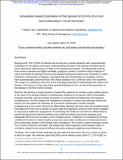Simulation‐based estimation of the early spread of COVID‐19 in Iran: actual versus confirmed cases
Author(s)
Ghaffarzadegan, Navid; Rahmandad, Hazhir
DownloadSubmitted version (657.2Kb)
Open Access Policy
Open Access Policy
Creative Commons Attribution-Noncommercial-Share Alike
Terms of use
Metadata
Show full item recordAbstract
Understanding the state of the COVID-19 pandemic relies on infection and mortality data. Yet official data may underestimate the actual cases due to limited symptoms and testing capacity. We offer a simulation-based approach which combines various sources of data to estimate the magnitude of outbreak. Early in the epidemic we applied the method to Iran's case, an epicenter of the pandemic in winter 2020. Estimates using data up to March 20th, 2020, point to 916,000 (90% UI: 508 K, 1.5 M) cumulative cases and 15,485 (90% UI: 8.4 K, 25.8 K) total deaths, numbers an order of magnitude higher than official statistics. Our projections suggest that absent strong sustaining of contact reductions the epidemic may resurface. We also use data and studies from the succeeding months to reflect on the quality of original estimates. Our proposed approach can be used for similar cases elsewhere to provide a more accurate, early, estimate of outbreak state.
Date issued
2020-01Department
Sloan School of ManagementJournal
System Dynamics Review
Publisher
Wiley
Citation
Ghaffarzadegan, Navid and Hazhir Rahmandad. "Simulation‐based estimation of the early spread of COVID‐19 in Iran: actual versus confirmed cases." System Dynamics Review 36, 1 (January 2020): 101-129 © 2020 System Dynamics Society
Version: Original manuscript
ISSN
0883-7066
1099-1727